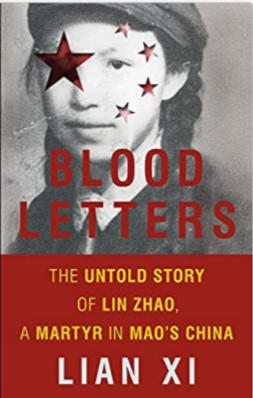Blood Letters: The Untold Story of Lin Zhao, a Martyr in Mao’s China by Lian Xi. Basic Books, 2018, 352 pages. Available on Amazon.

Blood Letters: The Untold Story of Lin Zhao, a Martyr in Mao’s China by Lian Xi was published in 2018, fifty years after Lin Zhao’s sentencing by the Military Control Committee and execution in Tilanqiao Prison, Shanghai. (p. 231) Lin Zhao was posthumously rehabilitated by the Chinese government in 1981. It is possible, however, that the publishing of this book would have held more value for her than her exoneration.
Near the end of her life, in a blood letter to her mother, Lin Zhao wrote, “In the future, they [her blood letters written home] will make up yet another volume of either my complete published works or a posthumous collection of my papers” (p. 216). Her purpose for writing those letters was stated on another occasion as, “[not] only are they true records of my life and feelings during this period, they are also forceful denunciations of these totalitarian thieves!” (p. 212)
Lin Zhao wrote throughout her life, but during her seven years of imprisonment,1 she wrote, first in hope of impacting Communist leaders, including Mao himself,2 leading to their repentance; then, she wrote in defense of herself and others; finally, she wrote simply to make her voice heard.
Lin Zhao was silenced by death but now, through Lian Xi’s meticulously researched and beautifully written book, her life and excerpts of her writings are available to the English-speaking world.
Biography
Xi’s book about Lin Zhao is far more than a biography, although it is a somber, unsparing, and ultimately inspiring account of her life.
Xi recounts the story of Lin Zhao’s life from her time as a student at the Laura Haygood Memorial School for Girls—a Southern Methodist mission school for girls from upper class families (p. 16)—through her years as a proponent, and sometime member, of the Chinese Communist Party (CCP), into her disillusionment with the CCP and its leaders, leading to her denouncement as a Rightest and her subsequent arrest, years of imprisonment, conviction, and execution.
He traces her initial steps of faith including her baptism at the Laura Haygood school (pp. 18, 19), the time of distancing herself from Christianity—or at least hiding her faith—during her active involvement in the CCP, her return to a more public faith as a student at Peking University, and the deepening and open witness of her faith during imprisonment. There may be some question as to whether or not she turned from her faith while serving the CCP, but it is clear through her prison writings that it was her faith that sustained her through that time and gave her the courage and strength to continue to stand against Mao’s regime.
Because of the impact of the choices of her family and friends on her life, and reciprocally the impact of her choices on them, Xi includes events and details of their lives as well, adding breadth and depth of understanding to Lin Zhao’s story.
Difficulties with alcohol, relationships, depression, possible mental illness, and recurrent serious physical illness (tuberculous) exacerbated by ill treatment and deprivation in prison are also documented. Xi gives a full picture of a real young woman in an extraordinarily difficult time. This is not hagiography.
History
Blood Letters is also a book of history. Xi often fills in fascinating details about the times in which Lin Zhao lived. For instance, when describing the horrific use of handcuffs during Lin Zhao’s detention,3 Xi includes a brief discussion of punitive handcuffing in China and history of the use of extortion in extracting confessions through torture in China beginning with the Western Zhou Dynasty (pp. 129-131).
In telling of Lin Zhao’s use of her own blood for writing (both out of necessity and as an extreme form of protest), he includes historical background on the tradition of blood writing in China, tracing it back to an early Buddhist expression of devotion (p. 135-136).
Xi also includes historical background on the various political movements, campaigns, and other events that Lin Zhao lived through and that impacted her. Reading Blood Letters is like reading an overview of that time but personalized by the impact it had on Lin Zhao, her family, and her friends.
Poetry
Blood Letters is also a book of poetry and other literature.
One thing I did not expect to find as I read Blood Letters was beautiful poetry and explanations of literary allusions, both Chinese and Western. Somehow, all I expected of writings in blood were the frantic scribbles of an abused and desperate prisoner trying to somehow communicate her extreme distress. Indeed, Lin Zhao was abused and desperate to communicate to those who had wrongfully imprisoned her and to others whom she hoped could somehow extend her aid from outside China and then to her family. However, there is far more here. In addition to her studies at the Laura Haygood school, Lin Zhao was admitted to the Chinese department at Peking University as a journalism major and was an accomplished writer and poet. She had used her writing skills as a student at the CCP School of Journalism and for a time wrote “revolutionary prose” (p. 39). Then, during her studies at Peking University and her consequent denunciation, she returned to writing essays, a play, and poetry—often in strict classical style, often with historical or literary allusions. For instance, Xi tells us:
Lin Zhao’s “Self Eulogy” was a four-character rhyme of sixty-four lines and employed the oldest Chinese poetic form, dating from almost three millennia ago. “Once straying down the wrong path,” she wrote, “I have now turned back!/ . . . My young heart was then pure as water, / Heaven, bear me witness against their attack!” Like the ancient Jing who had sung his heart out on the streets of Yanjing (now Beijing) before setting off on a doomed attempt to assassinate the monstrous, future First Emperor of Qin, Lin Shao, he too, had “sung my songs on Yanjing’s streets.” Lin Zhao also had “no regrets to be the prisoner from Chu,” a reference to Zhong Yi, the faithful minister of the feudal state of Chu in the sixth century BCE, who never forgot his home state while serving as a prisoner of war. She continued:
Freedom is without a price,
yet within bounds my life lies.
Shattered jade is what I will to be,
offered to China as a sacrifice!” (pp. 134–135)
“Self Eulogy” was written just before she had attempted suicide and while she was brutally handcuffed. This was not an isolated occurrence; she often wrote in equally horrific circumstances with equally eloquent results. I did not expect this in Lin Zhao’s story.
Trivia
Finally, Blood Letters is a book of detail and even bits of fascinating trivia. The book, while well-written and engaging, is also an academic project with detailed documentation. The text, including introduction and afterword, is 247 pages long. The notes, bibliography, and index require an additional 78 pages—almost a quarter of the whole book is documentation and references.
In addition to having access to the collected prison writings of Lin Zhao which were released to her family at the time of her rehabilitation,4 Xi also interviewed surviving friends and family of Lin Zhao, fellow prisoners, and others with knowledge of her life and circumstances. The text is filled with quotations from her own writings and conversations with those who went through her life experiences with her.
There is also the occasional unexpected detail. For instance, we are told that the architect of the No. 1 Detention House, the first facility where Lin Zhao was imprisoned in Shanghai, was designed by a relative of the renowned architect I. M. Pei and used indigenous forms of architecture (p. 126). That would make a great question for a China-history trivia night.
In recent years, China as a society, and Christians as part of that society, have been subject to increasing government pressure and control. As the Chinese Communist Party under Xi Jinping has sought to reassert party control over all aspects of society, the specter of repression and imprisonment looms large. Indeed, church leaders have been arrested and detained as have leaders in other sectors of society. Some have said China is facing the worst repression since the Cultural Revolution, in other words since the time of Lin Zhao. Being able to read of Lin Zhao’s faith, courage, and resolve at this time in China’s history is a gift. It is a gift to those who personally are facing harsh times in China and to those of us who need to be praying for them.
Endnotes
- Lin Zhao was arrested in October 1960 and executed in April 1968. During that time, she was held at three different prisons in Shanghai and was released briefly on medical leave due to her tuberculous.
- Lin Zhao’s responses to Mao’s rule and to him as a human being were complex. She denounced him, defaced his image, ridiculed him, and prayed for him (pp. 164-165, 169, 212, 138).
- At one point, Lin Zhao was manacled for six and a half months (p. 140).
- The Collected Writings of Lin Zhao was privately published in 2013 and includes prison writings, other works, and correspondence. A portion of Lin Zhao’s prison records have not been released and remain inaccessible as classified documents (p. 9-10).

Narci Herr
Narci Herr and her husband, Glenn, lived for just over 30 years in Hong Kong. They were first involved in working with the church in Hong Kong and then for the last 20 years of their time in Asia they served workers living in China. During that time Glenn traveled extensively throughout China and Narci …View Full Bio